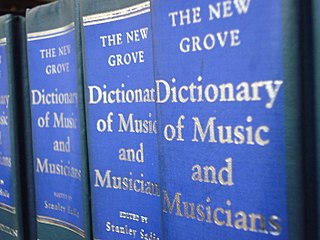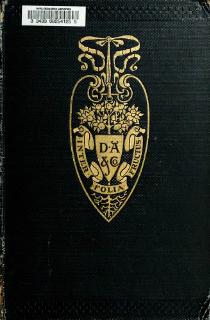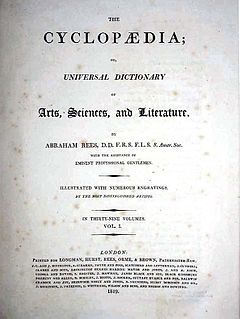
The Dewey Decimal Classification (DDC), colloquially the Dewey Decimal System, is a proprietary library classification system first published in the United States by Melvil Dewey in 1876. Originally described in a four-page pamphlet, it has been expanded to multiple volumes and revised through 23 major editions, the latest printed in 2011. It is also available in an abridged version suitable for smaller libraries. OCLC, a non-profit cooperative that serves libraries, currently maintains the system and licenses online access to WebDewey, a continuously updated version for catalogers.

The Oxford English Dictionary (OED) is the principal historical dictionary of the English language, published by Oxford University Press (OUP). It traces the historical development of the English language, providing a comprehensive resource to scholars and academic researchers, as well as describing usage in its many variations throughout the world. The second edition, comprising 21,728 pages in 20 volumes, was published in 1989.

The Dictionary of National Biography (DNB) is a standard work of reference on notable figures from British history, published since 1885. The updated Oxford Dictionary of National Biography (ODNB) was published on 23 September 2004 in 60 volumes and online, with 50,113 biographical articles covering 54,922 lives.

The New Grove Dictionary of Music and Musicians is an encyclopedic dictionary of music and musicians. Along with the German-language Die Musik in Geschichte und Gegenwart, it is one of the largest reference works on western music. Originally published under the title A Dictionary of Music and Musicians, and later as Grove's Dictionary of Music and Musicians, it has gone through several editions since the 19th century and is widely used. In recent years it has been made available as an electronic resource called Grove Music Online, which is now an important part of Oxford Music Online.

Appletons' Cyclopædia of American Biography is a six-volume collection of biographies of notable people involved in the history of the New World. Published between 1887 and 1889, its unsigned articles were widely accepted as authoritative for several decades. Later the encyclopedia became notorious for including dozens of biographies of people who had never existed. The apostrophe in the title is correctly placed and indicates that more than one person, i.e. a company, authored the work.

The Devil's Dictionary is a satirical dictionary written by American Civil War soldier, journalist, and writer Ambrose Bierce consisting of common words followed by humorous and satirical definitions. The lexicon was written over three decades as a series of installments for magazines and newspapers. Bierce's witty definitions were imitated and plagiarized for years before he gathered them into books, first as The Cynic's Word Book in 1906 and then in a more complete version as The Devil's Dictionary in 1911.

Collier's Encyclopedia is a discontinued United States-based general encyclopedia published by Crowell, Collier and Macmillan. Self-described in its preface as "a scholarly, systematic, continuously revised summary of the knowledge that is most significant to mankind", it was long considered one of the three major contemporary English-language general encyclopedias, together with Encyclopedia Americana and Encyclopædia Britannica: the three were sometimes collectively called "the ABCs".

The Gentleman's Magazine was a monthly magazine founded in London, England, by Edward Cave in January 1731. It ran uninterrupted for almost 200 years, until 1922. It was the first to use the term magazine for a periodical. Samuel Johnson's first regular employment as a writer was with The Gentleman's Magazine.

Rees's Cyclopædia, in full The Cyclopædia; or, Universal Dictionary of Arts, Sciences, and Literature was an important 19th-century British encyclopaedia edited by Rev. Abraham Rees (1743–1825), a Presbyterian minister and scholar who had edited previous editions of Chambers's Cyclopædia.

Who's Who is a source of biographical data on more than 33,000 influential people from around the world. Published annually since 1849, and as of 2015 in its 168th edition, it lists people who influence British life, according to its editors. Entries include judges, civil servants, politicians and notable figures from academia, sport and the arts.
The Dictionary of Canadian Biography is a dictionary of biographical entries for individuals who have contributed to the history of Canada. The DCB, which was initiated in 1959, is a collaboration between the University of Toronto and Laval University. Fifteen volumes have so far been published with more than 8,400 biographies of individuals who died or whose last known activity fell between the years 1000 and 1930. The entire print edition is online, along with some additional biographies to the year 2000.

The Kokusho Sōmokuroku (国書総目録)loosely, "General Catalog of National Books") is a Japanese reference work that indexes books published in Japan or written by Japanese before 1867. First published by the Iwanami Shoten company in 1963, an expanded edition was released in 1989. In its current edition, the Kokusho Sōmokuroku consists of eight volumes, in addition to an author index and appendix. The catalog was put together by compiling over one million library catalog cards from over 600 libraries across Japan in an effort to catalog books published before the Meiji Restoration still in existence that were written in Japan or by Japanese nationals. The catalog does not contain Chinese classics, Buddhist scriptures, or books from non-Japanese sources.
The New Catholic Encyclopedia (NCE) is a multi-volume reference work on Roman Catholic history and belief edited by the faculty of The Catholic University of America. It was intended by the faculty to become, like its predecessor the 1914 Catholic Encyclopedia, a standard reference work for students, teachers, librarians, journalists, and general readers interested in the history, doctrine, practices, and people of the Catholic faith. However, unlike its predecessor, its first edition also contained more general articles on science, education, and the liberal arts. The NCE was originally published by McGraw-Hill in 1967. A second edition, which gave up the articles more reminiscent of a general encyclopedia, was published in 2002 and was listed as one of Library Journal's "Best Reference Sources" for 2003.

Monographic series are scholarly and scientific books released in successive volumes, each of which is structured like a separate book or scholarly monograph.

Variety is an American media company owned by Penske Media Corporation. It was founded by Sime Silverman in New York in 1905 as a weekly newspaper reporting on theater and vaudeville. In 1933 it added Daily Variety, based in Los Angeles, to cover the motion-picture industry. Variety.com features breaking entertainment news, reviews, box office results, cover stories, videos, photo galleries and more, plus a credits database, production charts and calendar, with archive content dating back to 1905.
Harrison's Reports was a New York City-based motion picture trade journal published weekly from 1919 to 1962. The typical issue was four letter-size pages sent to subscribers under a second-class mail permit. Its founder, editor and publisher was P. S. Harrison (1880–1966), who previously had been a reviewer for Motion Picture News, in which his column was titled "Harrison’s Exhibitor Reviews".
Harrison's Reports and Film Reviews is the 15-volume reprint of the complete run of the weekly magazine Harrison's Reports from its founding in 1919 to its demise in 1962. Volumes 1 through 14 are facsimile reprints of the more than 2,000 weekly issues. The reprints were edited by D. Richard Baer and published 1992-1995 by Hollywood Film Archive.
Variety Film Reviews is the 24-volume hardcover reprint of feature film reviews by the weekly entertainment tabloid-size magazine Variety from 1907 to 1996. Film reviews continued to be published in the weekly magazine after the reprints were discontinued.
The Lincoln Library of Essential Information was originally published as a one-volume general-reference work, in 1924. In later years, it was published in two- and three-volume editions, and the title was changed.
The New Standard Encyclopedia was the most common name for an encyclopedia that ran from 1910 to the mid-1960s.












